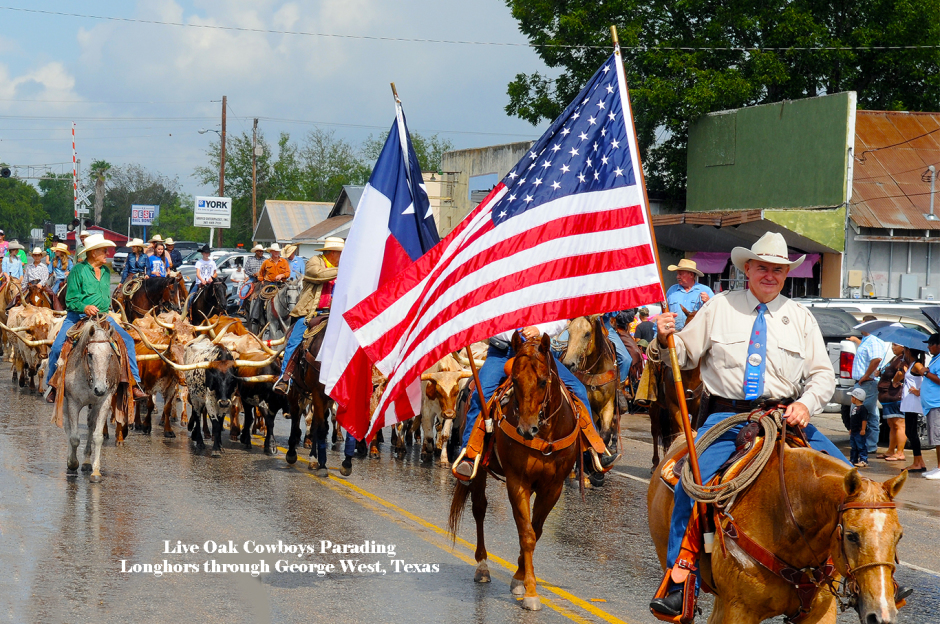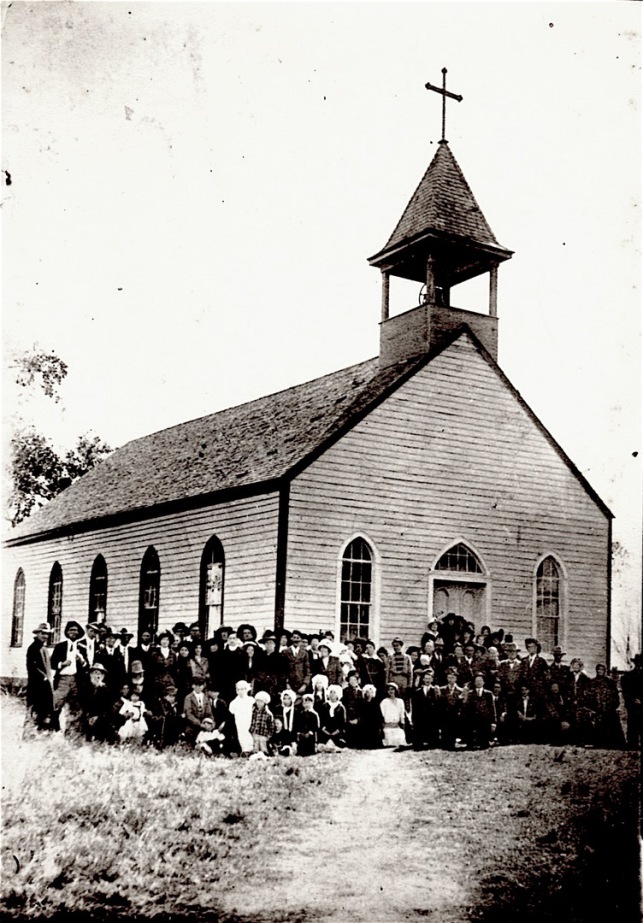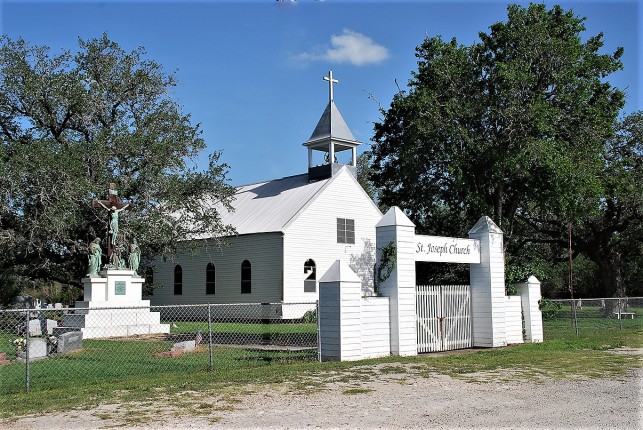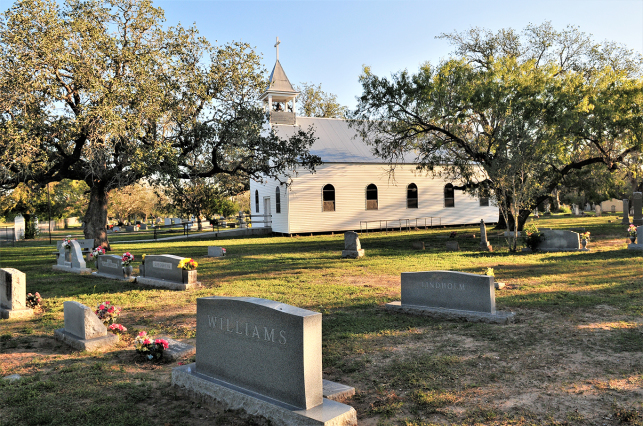
Gussettville
St. Joseph Church and Cemetery hold the legacy of Gussettville's early Irish in Live Oak County from burials in the 1830s forward. A group of parishioners stands in front of this second building constructed about 1876. It sits on two acres of land donated by Thomas and Anne Shannon. In 1905, Bridget McGloin donated an adjoining two acres for the Gussettville Cemetery. The church is still active with Masses celebrated on the Feast Day of St. Joseph and All Souls Day. It is also available for weddings, funerals andthe annual Gussettville Cemetery Reunion in October.
Gussettville Marker was one of the first state markers dedicated by the Texas Historical Commission and the Live Oak County Historical Commission (LOCHC). The earliest cemetery for the Irish is nearby on the Guy James property.
To obtain this early marker, LOCHC worked through the auspices of County Judge Harry L. Hinton and County Commissioners: Precinct 1, Lee Troell; Precinct 2, Elmer House; Precinct 3, Tom Bomar; and Precinct 4, Lloyd Miller in 1967.
Reverend Pietro was then resident pastor of St. George and served St. Joseph.
The Gussettville marker is placed in front of St. Joseph Church but is a community marker not specific to St. Joseph as a church or cemetery marker, though both are mentioned. See marker inscription below.
Photo and information gathered from The People's History of Live Oak County, Texas by Ervin Sparkman and Richard Hudson interview with Lamar James of George West. A complete legacy of these people through 1999 can be found in Texas Roots by Margaret Goynes Olson.
Live Oak County Judge: Honorable Harry L. Hinton
Live Oak County Historical Commission and Marker Chair: S.T. Brown, Jr.
LOCHC Marker Narrative: Thelma Lindholm
Gussettville Sponsor: Thelma Lindholm and Church members
Date Unveiled: 1967
Gussettville Subject Marker Text:
GUSSETTVILLE*
FOUNDED BY IRISH CATHOLICS OF McMULLEN AND MCGLOIN COLONY IN 1830'S. CALLED "FOX NATION" FOR THE FOX FAMILY ~ WAS RENAMED GUSSETTVILLE IN 1850'S IN HONOR OF N. GUSSETT, OWNER OF GENERAL STORE. FIRST CATHOLIC CHURCH IN LIVE OAK COUNTY BUILT HERE 1874. LAND FOR CHURCH AND PART OF THE CEMETERY WAS GIVEN BY THOMAS SHANNON AND HIS WIFE ANNE.
A STAGECOACH STOP ON SAN ANTONIO-BROWNSVILLE LINE, TOWN PROSPERED UNTIL BY-PASSED BY RAILROAD. TYPICAL OF HUNDREDS OF EARLY TOWNS THAT FADED AS TRAIN SERVICE DIVERTED TRAFFIC. CHURCH IS CHIEF REMAINING STRUCTURE. (1967) Marker is property of State of Texas.
APPLICATION NARRATIVE FOR OFFICIAL TEXAS HISTORICAL SUBJECT MARKER:
Gussettville
Fox Nation, later known as Gussettville, needs clarification. No records are recorded in the Deed Record Book K. 1. Live Oak County File No. 167, which is copy of Records from San Patricio Book No. B. 1, filing claims from anything until N. Gussett acquired the store.The Note: on the map from National Archives gives a date for the Post Office, 1858 ... may have been earlier, please refer to inclosed [sic] map for note date.
Then why Fox Nation at all? The first Irish settlers in the upper region of the McMullen, McGloin land grants were
either Fox by name or related to Fox and they all settled in a close area. Many of their descendants live in the area yet.
Mr. Norwick Gussett was a native of Guilford, North Carolina. He enlisted in 1845 in Taylor's Army of Occupation. He was at the storming of Vera Cruz, Pueblo, the capture of Churubusco, Contreas, Molina del Rey, and finally the call of Chapultepec Castle, and the hoisting of Stars and Stripes over the National Palace. The war was over. Sergeant Gussett was mustered out of service at Ft. Davis, receiving a medal for bravery under fire. Gussett married Miss Harriett Elizabeth ------ , of Detroit, Michigan. They married in Corpus Christi. Later he and his wife and infant daughter Clara Matilda, moved to a settlement in the McMullen and McGloin Colony. Here he opened a general store, and the thriving settlement, known as Fox Nation, took the name of Gussettville and still goes by that name.
The child, Clara Matilda, died in 1854 at the age of two years; and in 1863 Harriet Elizabeth died. Later Mr. Gussett married Miss Margaret Evans of the Colonel Kinney Colony, from the British Isles. They were married in Nueces County, but a wedding reception was had for them in Gussettville. Later the Gussetts sold their merchantile business to S. W. Lewis and moved back to Corpus Christi. (1)
An election on the Prohibition question was posted for Tuesday, September 2, 1890. The election was held in the general
store in Gussettville. The results are given by precincts, Gussettville is listed as Precinct No. 5--For Prohibition
2--Against, 8. The Poll-Tax at this date was 75 cents. (2)
Live Oak County's population in 1896 was given as 2,055. Six towns are listed, Gussettville is credited with 30. (3)
Mr. W. Lewis sold Stock cattle $5.00 per head, Steer cattle $10.00 per head. (4)
Water for the stock as well as for the house use was getting to be a problem, river fronts were being fenced. A group of
citizens from over Live Oak County met with County Commissioners 1882 to see if the county would fence lanes to the rivers so the back places would have access to water, nothing came of that, wells
and tanks were the solution. (5) This need of water was sufficient in itself to influence folks thinking. Just when or where water switching first came into practice is not known. Each reader is free
to give his own derivation of the use of the word "switching".
Mrs. Sarah Robinson, wife of Alfred Robinson switched for water wells. (6) She was of the Ramirena (corrected to
Ramirena) community, but she "switched" in Gussettville and other neighboring communities. Mr. S. W. Lewis had her switch a well for him. It is said she received $5.00 for the Lewis well. (7) Some
reader will be inclined to be a "doubting Thomas," but it worked ... some say it still works. Grandma Robinson used
a plum or peach or more likely a mesquite switch. A forked switch was selected, holding the prongs of the switch in her hands, the apex up, she then moved about over the desired location of the water
well, if water was to be had the apex or point of the switch dropped directly over the place where water could be found.
It is doubtful if there have been many wells dug in Live Oak County, that have been "switched." Each community had its own switcher. (8)
Roads! if that word can be used to describe the travel trails of the early days, yet a map of the stage coach route from
San Antonio showing a stop at Oakville, Gussettville and Echo on to Brownsville was covered, "Coach leaves San Antonio at
6 AM Monday; arrives in Brownsville by 6 PM Wednesday. (9) Mr. Milton Dodson, now deceased, gave to W. H. Striebeck, former Resident Engineer and W. F. Pugh, former Live Oak County Roads Maintenance
man, deceased, information showing this Stage Coach stopped at Echo, Grover Place, Kivilin, D. Johnson place, Gussettville, then Oakville, on to San Antonio. (10)
They just had to have fast horses--there was not a bridge over a creek at that time either. Nor was there a bridge for crossing the Nueces river from Gussettville west-the river was forded at what was called the Shannon Crossing, marks of this River crossing can be seen today, just below bridge connecting Gussettville and Mikeska.
Commissioner's Reports by their Precincts on May 15, 1888 gives a very rough and interesting picture of the roads.
Gussettville was in Precinct No. 2, Pat Sheeran Commissioner. The Oakville and Lagarto road from Spring Creek to P. F. Shipp' s
lower gate just tolerable good, from Long Hollow about the same. Spring Creek to McKenzie's pasture gate, tolerable; all of the mile posts are up. Waller Gulley to Timon's lower gate in bad
condition; same road from Timon's gate to Johnson's gate, bad condition; same road from Johnson's gate to the Grover gate, bad condition." He goes on to report he has no culverts on his roads, but he
sees no indication of need for any. He does report the need of a road to Beeville from Gussettville.
Mr. Sheeran making his report from gate to gate, brings this story to mind:
Mr. Ed McMurray, of the Willie McMurray Ranch, about five miles south of Oakville, was riding home from Gussettville accompanied by Charlie
Lee Pugh, younger son of Charlie A. Pugh. Charlie Lee was a lad of perhaps five years old. This was one of those typical "Texas July days," and after opening and closing about a dozen gates [These
gates were made almost solid from verticle posts bound together] and about half that number of wire gaps; Mr. McMurray quoted Charlie Lee as having said, "Mr. Ed, I think I know why it is so hot; all
those gates keep the wind shut off." Gussettville has good roads from the North, South, East, and the West today. (11)
On February 10, 1892, the Commissioners' Court listed three pages, double column, with names of killers of [wild
bobcats] cats and coyotes. Men listed from Gussettville were J. J. Fox, J. A. Gallagher, J. J. Cude, Ed McGloin, and J. H. McMurray. May, 1892, coyotes were worth $1.00, cats 50 cents. Another time
there were two pages, double column, of names, but no different names from Gussettville.
So closed 645 pages of Book No. 5 of the Commissioners' Court Records; it did not finish anything; the lists continued in Book No. 6, etc., and the cats, coyotes, and jack rabbits
are here yet. One dozan jack rabbits' scalps or ears brought $1.00 bounty. [Jack rabbit bodies were skinned, used for multiple purposes, and meat eaten.]
Mr. R. Y. (Bob) Williams of George West has his father's Pocket Day Book. Mr. 0. P. Williams had a ranch on Ramirena
Creek, got his mail in Oakville, attended church in Lagarto; and taking the information from his memorandum book, he traded
at the N. Gussett Store in Gussettville. The dates in the book, purchasing is listed in Gussettville from January, 1871 through September, 1871.
One entry reads: May 1871, O.P. Williams bought from N. Gussett:
1 Hickory Shirt $ .50
1 Shirt .75
1 pr. Shoes 1.25
1 Coat pants (price obliterated)
1 pipe .20
[continued editing of OP Williams' Pocket Day Book will soon be finished. Please move beyond to the rest of this narrative which is complete including the endnotes.]
Another entry: May, 1871
1st. trip N. Gussett-------$
2nd. trip
3rd. trip
1 pr. Socks $.25
1 hat 3.75
2 pr. Socks .50
Tobacco .50
1 Blank Book .35
!+th trip 7 yds.
2.75
17.32
8.78
checks •. $1. 75 1 hat--$2.00
Then on March 27th:
1 pr. Bridle reins----
1 can peaches
$.75
.25
half lb. crackers .12~ 12
Mr. Williams
flour
tobacco
Castor oil
records
$1.00
.40
.25
his items of September 15, 1871
1 box .25
1 box grease .20
These items do not have the price given;
meal 1 ax and handle 1 lite (sic) undershirt
spurs 2 yds. Calico boots
roap matches
The above reads like a memorandum and so does the following:
flour sheepdip 1 hat
rasor soap coffee
salt boots
matches fiddle string
Below the above entry is this
1 plug tobacco $.35
1 handkerchief .72~
8 yds. Calico
2 yds. checks
1 can peaches .25
'f.
On June 4th these were purchased:
1 roap (price obliterated)
1 saddle $8.00
black flax thread 6 cents. 13
1 can peaches
Pills
.25
.25
These entries are interesting in point of the items on the market, the price, and in 1871 "peaches in
cans."
Gussettville had its school problems, as stated under Catholic Church most of the Priests taught secular subjects, but between 1856 and 1871, there are no recorded records on formal schooling, but it does not mean that during this fifteen year period the children of these pioneers had no formal education. Thomas Pugh and W. S. Lewis employed Mr. McGafney to teach their boys, the girls were sent to Corpus Christi and boarded in a Catholic private school. (14) The three Pugh brothers, Pat, Bat, and William employed Mr. John Gandy, from England to teach their children. He taught in a small log room in the Bat Pugh yard. This was the arrangement of their families of that time.
On the 20th of August, 1876, Judge G. W. Jones was petitioned to organize Live Oak County School Communities. The request was granted. There was a
Community School established in Gussettville. The records do not show who taught there the
first years. "The fee was 7 1/2 cents per day per pupil." "The County guaranteed payment of this tuition fee for orphans of widows."
The "Community" had no boundaries and by law, no means of controlling property. There was no designated location for the school; its site was
determined anew each year, as a result no permanent buildings were erected. The site or location of the
school was determined by the families of the Community in a home with space or a home where there were small children or girls---boys and older children could ride several miles to school. In a home
of a large family, if the teacher could be taken care of, the children were usually taught for the "teacher's keep".
The Community School law was replaced in 1883, the State adopted the District System, under this system educational responsibility was placed on the
County under the direct supervision of the County Judge. Mr. Charles Arrick of Missouri taught in Gussettville. Judge C. C. Cox makes a report of the County Schools by districts, school term of
1894-95: Gussettville Dist. No. 5, No. of children, 26. The list gives the number for the entire county to be 622 children. The school in Gussetville
continued to grow, new buildings were built to meet the needs of the district, but as time passed there were not teachers to fill all places, so on September 10, 1943, Gussettville joined the George
West Independent School District.
Remarks on Gussettville would not be complete without mention of the Telephone. A franchise was given the Southwestern Bell Telephone Company in 1912.
There was
a line extending from Oakville south connecting Willie McMurray, Ed McMurray, Charlie Pugh, Kellners, Norwood, Kaase, on into the heart of Gussettville; Waltons, Mr. s (sic) B. B. Gallagher, Willie
Lewis (Yellow Bill) and the Dolans; the line terminated in
Mikeska. There were thirteen connected to the same line. That was a broad example of a Party line. You just took the receiver off the hook and listened for your turn to enter into the conversation.
(15)
Gussettville is still here and many more pages could be written of her people, but her story will be closed as was several other Live Oak County's
towns with the by-passing of the Rail Road. The S.A.U. and G. was built through Mikeska a mile or so west of the Nueces River, and perhaps Gussettville was doomed when in 1856 N. Gussett lost his
appeal that the County capital be located in his town, Gussettville.
Documentation
(1) Josephine Gussett Reynolds was the Grandmother of Mrs. A.F. Grimsinger of Karnes City and the Great-grandmother of Robert and Jim Dougherty of George West, making
them direct descendants of N. Gussett. Interview, Robert Dougherty, 8/16/67.
(2) Minutes of Commissioner's Court, Live Oak County. George West, Texas, Vol. III p. 28.
(3) Minutes of Commissioner's Court, Live Oak County, George West, Texas Vol. III p. 340.
(4) Ibid, p 320.
(5) Lagarto News, Lagarto, October 13, 1882, Library of Thelma Lindholm.
(6) Bob Williams, formerly of Ramirena, now living in George West--interview.
(7) Jimmy Gallagher, grandson of S. W. Lewis, interview 8/16/67.
(8) Op. cit. and Ibid 8/16/67.
(9) Copy of Map included with article, National Archives, Washington, D. C.
(10) Paper from Dodson to Striebeck and Pugh, 8/16/67. Library of Thelma Pugh Lindholm.
(11) Map
(12) No explanation given on the half cent.
(13) This Pocket Note Book is in the Library of R.Y. (Bob) Williams George West 8/16/67 O.P. Williams was Bob's father.
(14) Katherine Pugh, deceased, to Thelma Lindholm.
(15) The Charlie Pugh Telephone Box is in the home of Thelma Pugh Lindholm 8/16/67.
Thanks to Lynette Chen, Sarah McClesky, and Bob Brinkman, Director at the THC Marker Archives in Austin for sharing this narrative and folder information.
[Above: Some ambiguities occur in transcription from literally type written pages to the digital page. Therefore, endnotes and hand corrections are placed in parentheses. Every care is made to preserve original in readable format.
Readers interested in cultural notes will find "switching to find water", "bounty payment for excess wildlife", "roads", "cost and merchandise", "schools", "telephones" and a few other sundry items especially interesting.]



